Zweig Breadth Thrust Signal
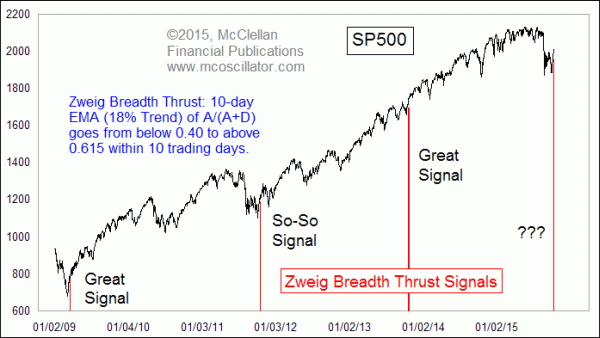
Free Chart In Focus email
Delivered to you every week
Technicians have a lot of versions of a “breadth thrust” signal, and the basic idea is that the Advance-Decline numbers suddenly go from not so good to REALLY good in a short amount of time. The late Martin Zweig was one of the first to examine this phenomenon, and he came up with specific criteria for what is now known by technicians as a Zweig Breadth Thrust (ZBT) signal.
Zweig quantified this idea by first calculating a ratio of the number of advances divided by the sum of advances plus declines. In other words, A/(A+D). Then he calculated a 10-day EMA of that ratio, which we would call an 18% Trend according to our preference for the originalist terminology. To get a Zweig Breadth Thrust signal, that ratio needed to go from below 0.40 to above 0.615 in 10 trading days or less. The idea is that when there is such a signal, it is a sign that a rapid surge of money is trying to push its way through the door to get into the market, and that is a sign of continuing liquidity to fuel an uptrend.
I have played around with those thresholds, because they do not tend to produce very many signals. But as I loosened the criteria at either end, I did get more signals, but the quality of those signals went down.
One point to note about this signal is that there were not any of them from 1984 to 2004. 20 years is a really long time to go without any signals for an indicator like this. It should be understood that Zweig did his work on this signal long before that drought period, when the market was arguably operating on different rules of physics, so it is not a fault of Dr. Zweig that his signal went for 20 years without doing anything.
I bring all of this up because we just got another instance of this signal this week, and so that makes it worth examining. The 20-year signal drought ended back in May 2004, a signal that was not so great because there was a significant pullback afterward (see below). But then in 2009 we a great signal since it was followed by many more months of strong upward movement. Another signal came in October 2011, following an ugly decline after the Fed ended QE2. Its effect was so-so, as the pop ended and the market fell back before starting a new uptrend in earnest.
In October 2013 (why is it October so often?), there was another signal as QE3 was fueling a big bull market, and it too was considered a good signal.
But 3 prior signals over the past 6 years is not a statistically significant batch of signals to examine. So let’s take it all the way back to 1928 and see what it was that Dr. Zweig was looking at. The short answer is: The results are not as good as one might hope, and it matters whether the market is in an uptrend or a downtrend. Let’s look at the charts.
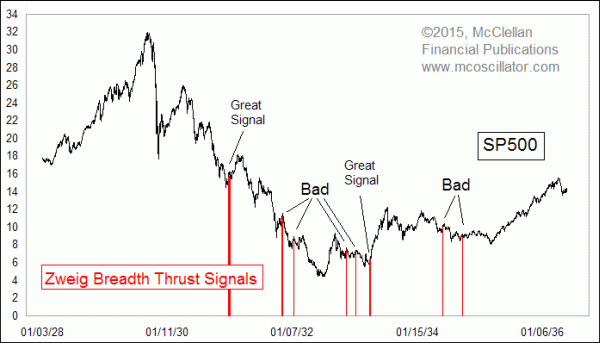
During the 1929-32 bear market, there was one great signal, at least for a few months, arriving in November 1930. But its bullish effect petered out after just a few months, and the bear market was back on. Four more bad signals each marked the ends of failing pops for stock prices. It was only in April 1933 that there was finally a good signal that led to follow-on buying. Then in 1934 there were two signals, each of which were not followed by more upside movement.
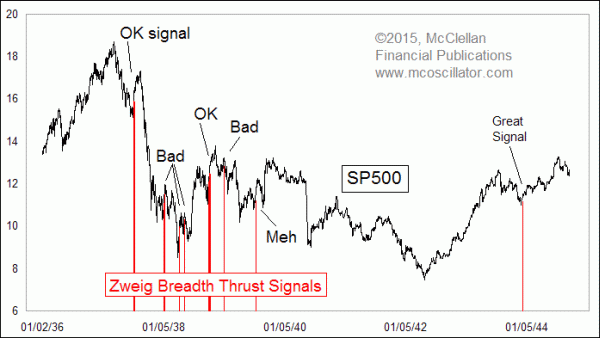
The late 1930s saw a continued mixture of good and bad signals. Some were okay, some were spectacularly bad as signals of a possible new bull market. It is worth noting that the major bottoms in 1940 and 1942 saw no signals. Only when we got to late 1943 did a real signal trigger, and it was a pretty good one.
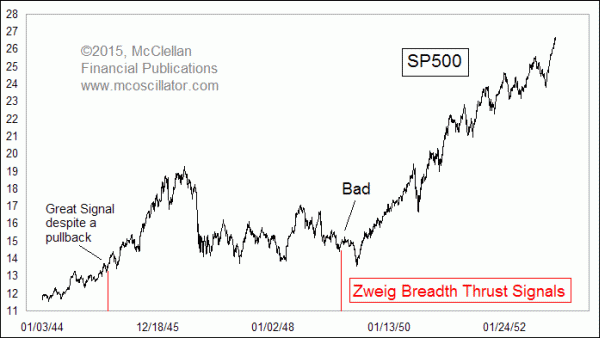
From 1944 to 1952, there were only two signals. The one on Feb. 3 was a really good one, leading to a lot more uptrend. But the one on March 8, 1949 was a really bad one, marking the end of a half-hearted pop. It would have been great to have had one of these signals coming out of the bottom which followed, but that is not how the numbers fell out. And the rest of the 1950s saw no signals.
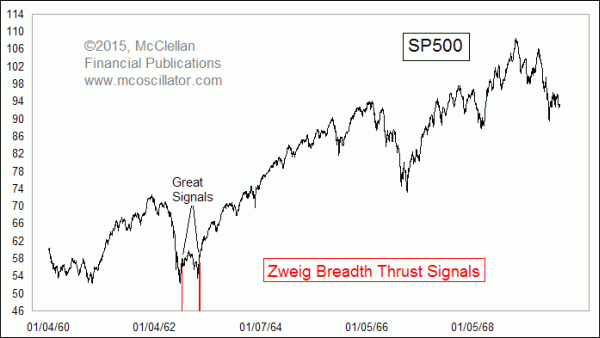
1962 saw two signals. One was right after the June 1962 bottom, and the second was in November 1962, after the selloff related to the Cuban Missile Crisis. Both were pretty good signals.
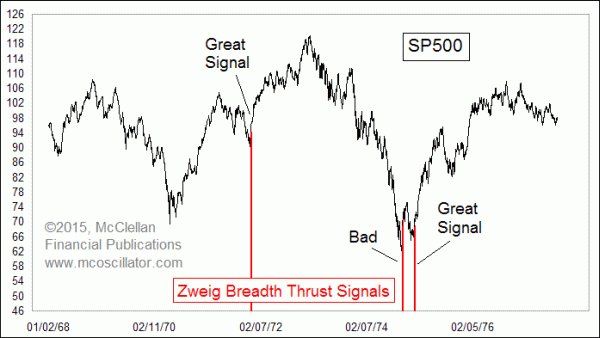
The early 1970s saw only 3 signals. The one in 1971 was great, and just the sort of signal one would like to get. But 1974 was screwy, with an Arab Oil Embargo and a presidential near-impeachment that led to a resignation.
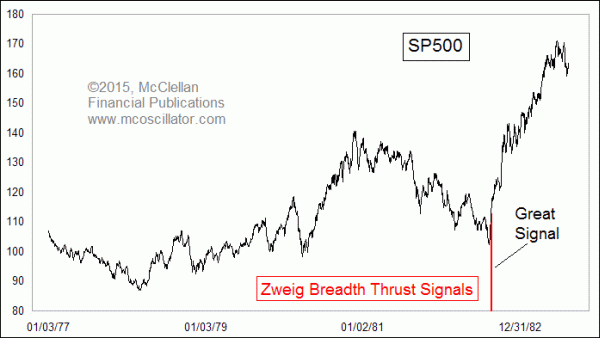
1982 saw a wonderful signal, coming in August 1982, at the start of arguably the best bull market of all time.
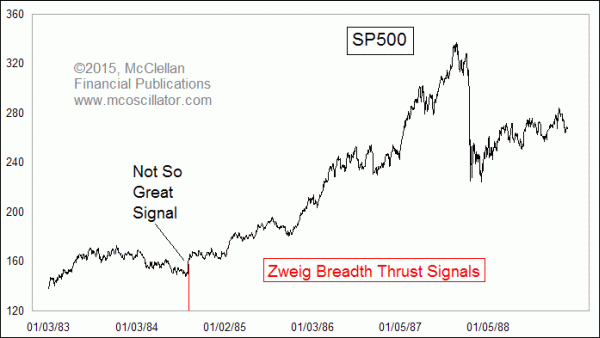
That last signal of the pre-modern era was not so great. August 1984 saw a pop after a long and gradual downtrend, and while it did lead to more upward movement for the SP500, that continuation took a long time to arrive. So we cannot score this one as a big positive.
After a 20 year drought in signals, we finally saw another one in May 2004. The market coasted higher for a few days after that signal was generated, but then saw a significant decline afterward, so call it a so-so signal.
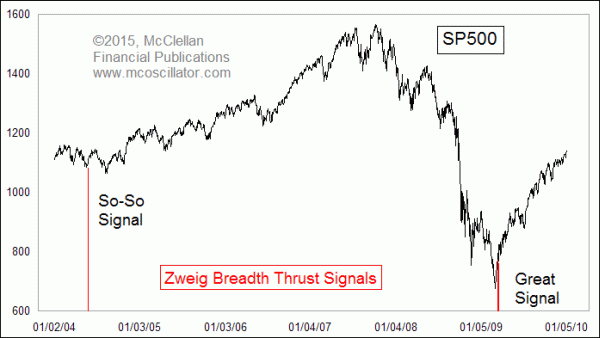
So here is the official tally of all of the Zweig Breadth Thrust signals over 87 years of market breadth history:
Signal type Quantity
Great! 11
Meh… 4
Horrible 12
I am one of the biggest believers in the world about the idea of stock market breadth being one of the best tools we have to indicate financial market liquidity. But based on this evidence, I cannot offer much in the way of optimistic commentary about this current ZBT signal, especially since it has occurred at a point that appears to be the early stage of a new downtrend. Robust rallies within downtrends are great opportunities to get ready for the next phase of the downtrend. The problem is that they often disguise themselves that way, when in reality a new uptrend is beginning after a long bear market. This current moment does not seem like the end of a long bear market just yet.
Tom McClellan
Editor, The McClellan Market Report
Aug 21, 2015
Eurodollar COT Says Ugly Drop Is Still Ahead of Us |
Jul 24, 2015
RASI Shows Bull Market Waning |
Jun 11, 2015
The Magic of 150 Months |